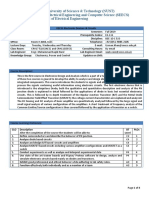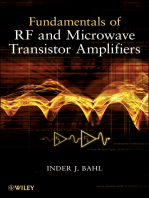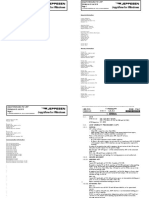Important Edc Tasks
Uploaded by
Umer Farooq AzamImportant Edc Tasks
Uploaded by
Umer Farooq AzamHelen and John C.
Hartmann Department of Electrical and Computer Engineering
New Jersey Institute of Technology
ECE 271 Electronic Circuits I. 3 credits
Instructor: Dr. Serhiy Levkov. E-mail: levkov@njit.edu WEB: http://web.njit.edu/~levkov/ Phone: 973 642 7676.
Text Microelectronic Circuit Design / Jaeger & Blalock, 5th Edition, McGraw Hill, 2011. ISBN 978-0-07-338045-8
Course description: The electronic devices, junction diodes, bipolar transistors and field-effect transistors, are introduced
and studied based on semiconductor physics models. The study then continues with analysis and design of main digital
electronic circuits (NMOS and CMOS inverters and logic gates, MOS memory and storage circuits), and with
introduction to analog electronic circuits such as simple one transistor amplifiers.
Required course. Prerequisite ECE 231. Corequisite ECE232.
Specific course learning outcomes
By the end of the course students are supposed to being able to perform the following tasks.
# Topic Outcome
1 2 Calculate the major physical parameters in doped semiconductors and pn-junctions.
2 3 Analyze (calculate voltages and currents) simple diode circuits using different diode models. 1
3 3 Design different types of rectifier circuits and analyze them (find voltages, currents and sketch their time graphs)1
4 4 Demonstrate the knowledge of MOSFET (JFET) region models and their IV-characteristics. Draw the IV-
characteristics of a MOSFET from its parameters and find parameters using the IV-characteristics. 1
5 4 Analyze (calculate voltages and currents) a simple MOSFET (JFET) bias circuit and find its Q-point.
6 4 Design a simple MOSFET (JFET) bias circuit for a given specification.
7 5 Identify different models of BJT, regions of operations, and their IV-characteristics. 1
8 5 Analyze (calculate voltages and currents) a simple BJT circuit and find its Q-point. 1
9 5 Design a simple BJT bias circuit for a given specification..
10 6 Formulate the concept of ideal operational amplifier; identify its major properties and main types of op-amps
circuits.
11 6 Analyze the simple circuits that include op-amps (find voltages and currents using op-amps properties and circuit
laws) . 1
12 6 Analyze one transistor (MOSFET, BJIT) amplifier circuit (draw DC, AC, small signal model equivalent circuits,
find their parameters and parameters of amplifier).
13 7 Identify the different types of NMOS logic inverter gates and list their major benefits and deficiencies.
14 7 Design and analyze (find logic voltage levels and currents) 5 types of NMOS inverter gates
15 7 Design the NMOS logic gate circuit for a given logic function and specifications. Determine the logic function of a
complex NMOS logic gate.
16 8 Draw a CMOS inverter gate voltage transfer characteristic from IV-characteristics of a NMOST and PMOST.
Identify and explain its regions.
17 8 Design the CMOS logic gate circuit for a given logic function and time response specifications. Determine the logic
function of an arbitrary complex CMOS logic gate.
18 9 Draw the schematic of a static (6T) and dynamic (1T) memory cell and explain in details the process of reading
and writing a bit of information in it.
19 9 Draw the schematic of a typical sense amplifier and explain how it works
20 9 Draw a schematic of a simple (2-3 bit) NOR/NAND NMOS address decoder and explain how it decodes a given
address.
1
Includes use of Multisim simulation.
Student outcomes addressed by the course
1. An ability to identify, formulate, and solve complex engineering problems by applying principles of engineering, science, and
mathematics (CLO 2, 5, 7, 8, 11, 12, 14, 15,16).
2. An ability to apply engineering design to produce solutions that meet specified needs with consideration of public health, safety,
and welfare, as well as global, cultural, social, environmental, and economic factors (CLO 3, 6, 9, 14,15, 17).
6. An ability to develop and conduct appropriate experimentation, analyze and interpret data, and use engineering judgment to draw
conclusions (CLO 2,3,4,7,8,11).
7. An ability to acquire and apply new knowledge as needed, using appropriate learning strategies.. (CLOs 1, 4, 18, 19, 20)
Course Topics
Week Topic Topic details Text section
1 1. Introduction Intro and history. Analog and digital signals. AC-DC converters 1.1. 1.2
Review of circuit analysis 1.5
Elements parameter variation in circuit design 1.8
1,2 2. Semi- Semiconductor materials. Covalent bonds 2.1, 2.2
conductors Drift current and mobility 2.3
Doping. Diffusion and total currents 2.5-2.7. 2.8-2.9
PN junction physics 3.1
2,3 3. Diodes IV characteristics and equation. Reverse and forward bias. Reverse breakdown. 3.2-3.4
Diode models and diode circuit analysis 3.6
Diode analysis in breakdown region. 3.10, 3.11
Diode rectifier circuits and other applications 3.12,3.13-3.16
Test 1
4,5,6 4. MOSFET MOS transistor physics 4.1-4.2.0
NMOSFET analysis. PMOS transistor 4.2.1-4.2.8. 4.3
MOSFET circuit analysis and biasing 4.9-4.10
JFET Transistors 4.11
6,7 5. BJT BJT physics and models (npn-pnp) 5.1, 5.2, 5.3
IV characteristics. Circuit models simplification 5.5. 5.4-5.7
Biasing and circuit design 5.11
Test 2
8,9 6. Intro to OpAmps Amplifiers and two port models 10.2, 10.3
(Ampl. as a system) Op amp intro. Ideal op amp. Circuit analysis with op amps 10.5, 10.7. 10.8,10.9
Single transistor Transistor as an amplifier. DC, AC equiv. models 13.1, 13.2. 13.3
amplifier Small signal BJT model. Common emitter amplifier 13.4,13.5. 13.6, 13.7
(Ampl. as a circuit) Small signal MOSFET model. Common source amplifier 13.8, 13.9. 13.10, 13.11
10,11 7. Intro to digital Logical gates and definitions, Boolean algebra review 6.1, 6.2, 6.4
circuits NMOS inverter, resistive load. NMOS inverter, transistor load. 6.5. 6.6, 6.7
NMOS NAND and NOR gates. Complex NMOS logic design 6.8.1, 6.8.2. 6.9
Power dissipation. Dynamic behavior of NMOS gates 6.10. 6.11.1,2,3
12 Test 3
12,13 8. CMOS circuit CMOS inverter basics and Voltage Transfer Characteristic 7.1, 7.2
design CMOS inverter dynamic behavior. Power dissipation 7.3.1, 2, 3. 7.4
CMOS NAND and NOR gates. CMOS complex gates 7.5. 7.6, 7.7
13,14 9. MOS memory Static memory cells 8.2
Dynamic memory cells 8.3.1, 8.3.2. 8.4.1, 8.4.2
Sense amplifiers. Memory architecture and address decoders 8.1.1,2; 8.5.1,2
Read-only memory (ROM). Flip-flops 8.6. 8.7
15 FINAL EXAM
Homework Policy
The list of the assignment is on the course website and in Canvas. A significant number of homework problems will be
assigned for each topic. The homework will not be graded (solutions will be posted on the web); instead, short quizzes
(10p.each) will be conducted every week. 5 best results will be counted toward your quiz grade of 50.
Circuits simulation
Circuit simulation is very important part of the project. There will be five graded simulation assignments during the
course. A Multisim simulation project will be offered at the end of the course as an extra credit of up to 30p.
Grading Policy
The course grade will be based on tests and quizzes (and on the project for honors students):
3 Tests @100 points 300
Short Quizzes 50
Simulation assignments 50
Final examination (all inclusive) 100
Project (honors students only) (100)
Total 500
Tests and final exam are closed books and notes. A list of formulas will be provided by instructor.
NJIT Honor Code
NJIT Honor Code will be strongly upheld. Violation will be brought to the immediate attention of the Dean of Students.
You might also like
- Hourglass Workout Program by Luisagiuliet 276% (21)Hourglass Workout Program by Luisagiuliet 251 pages
- The Hold Me Tight Workbook - Dr. Sue Johnson100% (16)The Hold Me Tight Workbook - Dr. Sue Johnson187 pages
- Read People Like A Book by Patrick King-Edited62% (65)Read People Like A Book by Patrick King-Edited12 pages
- Livingood, Blake - Livingood Daily Your 21-Day Guide To Experience Real Health77% (13)Livingood, Blake - Livingood Daily Your 21-Day Guide To Experience Real Health260 pages
- COSMIC CONSCIOUSNESS OF HUMANITY - PROBLEMS OF NEW COSMOGONY (V.P.Kaznacheev,. Л. V. Trofimov.)94% (212)COSMIC CONSCIOUSNESS OF HUMANITY - PROBLEMS OF NEW COSMOGONY (V.P.Kaznacheev,. Л. V. Trofimov.)212 pages
- Donald Trump & Jeffrey Epstein Rape Lawsuit and Affidavits83% (1016)Donald Trump & Jeffrey Epstein Rape Lawsuit and Affidavits13 pages
- The 36 Questions That Lead To Love - The New York Times94% (34)The 36 Questions That Lead To Love - The New York Times3 pages
- The 36 Questions That Lead To Love - The New York Times95% (21)The 36 Questions That Lead To Love - The New York Times3 pages
- Jeffrey Epstein39s Little Black Book Unredacted PDF75% (12)Jeffrey Epstein39s Little Black Book Unredacted PDF95 pages
- The 4 Hour Workweek, Expanded and Updated by Timothy Ferriss - Excerpt23% (954)The 4 Hour Workweek, Expanded and Updated by Timothy Ferriss - Excerpt38 pages
- Sonia Richards - Week End 1 - Course Exercice100% (1)Sonia Richards - Week End 1 - Course Exercice10 pages
- EEE2002 Semiconductor Devices and Circuits - Win - 17 - 18No ratings yetEEE2002 Semiconductor Devices and Circuits - Win - 17 - 182 pages
- Op-Amp Applications: Summing, Integrator, Differentiator, V-I and I-V ConvertersNo ratings yetOp-Amp Applications: Summing, Integrator, Differentiator, V-I and I-V Converters3 pages
- 2018 ECE Annex V - Sample Course Specification For Electronic Devices and Circuit LectureNo ratings yet2018 ECE Annex V - Sample Course Specification For Electronic Devices and Circuit Lecture3 pages
- Download full CMOS Analog Design Using All Region MOSFET Modeling 1st Edition Márcio Cherem Schneider ebook all chapters100% (1)Download full CMOS Analog Design Using All Region MOSFET Modeling 1st Edition Márcio Cherem Schneider ebook all chapters77 pages
- 19ECE201 Analog Electronic Circuits Course PlanNo ratings yet19ECE201 Analog Electronic Circuits Course Plan2 pages
- basic electronics for 1st year new UG curriculmn (1)No ratings yetbasic electronics for 1st year new UG curriculmn (1)2 pages
- Applied Electronics and InstrumentationNo ratings yetApplied Electronics and Instrumentation192 pages
- RF and Microwave Circuit Design AssignmentNo ratings yetRF and Microwave Circuit Design Assignment2 pages
- Academic Affairs Office Indian Institute of Technology RoorkeeNo ratings yetAcademic Affairs Office Indian Institute of Technology Roorkee7 pages
- EE-215 Electronic Devices and Circuits Ver1.1 - Fall19No ratings yetEE-215 Electronic Devices and Circuits Ver1.1 - Fall194 pages
- CMOS Analog Design Using All Region MOSFET Modeling 1st Edition Márcio Cherem Schneider - Download the entire ebook instantly and explore every detail100% (1)CMOS Analog Design Using All Region MOSFET Modeling 1st Edition Márcio Cherem Schneider - Download the entire ebook instantly and explore every detail57 pages
- Ece1002 Semiconductor-Devices-And-Circuits Eth 2.1 47 Ece1002 PDFNo ratings yetEce1002 Semiconductor-Devices-And-Circuits Eth 2.1 47 Ece1002 PDF2 pages
- Se (Electronics) Sem-Iii Basics of Electronic Circuits: Hours MarksNo ratings yetSe (Electronics) Sem-Iii Basics of Electronic Circuits: Hours Marks3 pages
- Instant Download (eBook PDF) Analog Integrated Circuit Design by Simulation: Techniques, Tools, and Methods PDF All Chapters100% (1)Instant Download (eBook PDF) Analog Integrated Circuit Design by Simulation: Techniques, Tools, and Methods PDF All Chapters55 pages
- Introduction To Digital Integrated Circuits (DIC)No ratings yetIntroduction To Digital Integrated Circuits (DIC)13 pages
- Transform Calculus, Fourier Series and Numerical TechniquesNo ratings yetTransform Calculus, Fourier Series and Numerical Techniques3 pages
- Analoge and Digital Electronics Suggestion 2024No ratings yetAnaloge and Digital Electronics Suggestion 20242 pages
- BE2101 - Basic Electronics: (1 Semester - CS, IT) Credits: 3 Contact Hours: 3No ratings yetBE2101 - Basic Electronics: (1 Semester - CS, IT) Credits: 3 Contact Hours: 33 pages
- Connection-Oriented Networks: SONET/SDH, ATM, MPLS and Optical NetworksFrom EverandConnection-Oriented Networks: SONET/SDH, ATM, MPLS and Optical NetworksNo ratings yet
- Placement Project BMIH6006.8 - Autumn Term 2023 Handbook FINAL KF EE PDFNo ratings yetPlacement Project BMIH6006.8 - Autumn Term 2023 Handbook FINAL KF EE PDF20 pages
- Antipolo City Senior High School: Republic of The Philippines Department of Education Region Iv-A Calabarzon District I-ANo ratings yetAntipolo City Senior High School: Republic of The Philippines Department of Education Region Iv-A Calabarzon District I-A4 pages
- MCQ For SNVM Startup and New Venture ManagementNo ratings yetMCQ For SNVM Startup and New Venture Management24 pages
- DLL SHS STEM Grade 12 - General Biology1 Quarter1 Week1 (Palawan Division)100% (4)DLL SHS STEM Grade 12 - General Biology1 Quarter1 Week1 (Palawan Division)13 pages
- Interpersonal Relationship:: Raja Abdul Rehman FA19-BBA-199No ratings yetInterpersonal Relationship:: Raja Abdul Rehman FA19-BBA-1993 pages
- On The Use Non-Stationary Penalty Functions T o Solve Nonlinear Constrained Optimization Problems With GA'sNo ratings yetOn The Use Non-Stationary Penalty Functions T o Solve Nonlinear Constrained Optimization Problems With GA's6 pages
- Physics Lesson Notes On Heat Capacity and Specific Heat CapacityNo ratings yetPhysics Lesson Notes On Heat Capacity and Specific Heat Capacity5 pages
- Introduction To Oracle Linux - Shell and Command LineNo ratings yetIntroduction To Oracle Linux - Shell and Command Line1 page
- Machine Learning Guide: Meher Krishna PatelNo ratings yetMachine Learning Guide: Meher Krishna Patel121 pages
- Steps To Create Process - Control in GENTRAN - DIRECTORNo ratings yetSteps To Create Process - Control in GENTRAN - DIRECTOR8 pages
- Answer:: A: A Selection Text. B: A Basic List Row. C: A Page FooterNo ratings yetAnswer:: A: A Selection Text. B: A Basic List Row. C: A Page Footer21 pages























































































































